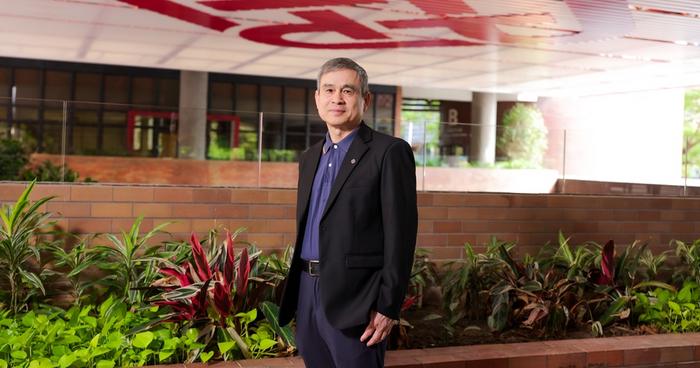Society relies heavily on diverse fluidic technologies. The ability toprecisely capture and release various chemical and biological fluids plays a fundamental role in many fields.A long-standing challenge is to design a platform that enables the switchable capture and release of liquids with precise spatial and temporal control and accurate volumes of the fluid. Recently, researchers at The Polytechnic University of Hong Kong (PolyU) have invented a new method to effectively overcome this challenge.
Society relies heavily on diverse fluidic technologies. The ability toprecisely capture and release various chemical and biological fluids plays a fundamental role in many fields.A long-standing challenge is to design a platform that enables the switchable capture and release of liquids with precise spatial and temporal control and accurate volumes of the fluid. Recently, researchers at The Polytechnic University of Hong Kong (PolyU) have invented a new method to effectively overcome this challenge.
Led by Prof. WANG Liqiu, Otto Poon Charitable Foundation Professor in Smart and Sustainable Energy, Chair Professor of Thermal-Fluid and Energy Engineering, of the PolyU Department of Mechanical Engineering, the research team has developed a unique fluidic processor, “Connected Polyhedral Frames” (CPFs). With CPFs, switching between liquid capture and release becomesreversible, programmable and independent of used polyhedral frames and processed liquids, making the processor a meta-metamaterial.This research has recently been published in Nature Chemical Engineering, with Dr ZHANG Yiyuan, Research Assistant Professor of the Department of Mechanical Engineering, as the first author.
Unlike in the highly developed area of solids manipulation, convenient handling of fluids remains a cumbersome task despite the ubiquity of fluids in, for example, the healthcare, pharmaceutical, biological and chemical industries. As fluids interact with tools, they frequently wet and spread on the solids, preventing complete liquid transfer, impairing volumetric accuracy and causing inter-sample cross contamination. To preserve the purity of fluids, disposable plastics such as pipettes and microtubes are widely used, adding to the global problem of plastic waste.
Reversible switching between capture and release is the key to CPFs’ capability to precisely process liquids, enabling the liquid in the network to be retained or drained locally, dynamically and reversibly as desired. In the CPFs, frames above the single-rod connection without a pathway for liquid drainage between frames, capture and retain liquids, thus functioning as capturers. While the frames above the double-rod connection imbibe but release liquids, serving as releasers. This is because when the CPFs are lifted from the liquid, a liquid film forms between the double-rod connections, creating channels between frames that facilitate liquid release.
Reversible switching between capture and release can be achieved, using available tools, by constructing or breaking the liquid continuity between frames. CPFs offer a versatile platform that enables many unique functions including 3D programmable patterning of liquids, 3D spatiotemporal control of concentrations of multiple materials, packaging of 3D liquid arrays and large-scale manipulation of multiple liquids. It is compatible with a broad range of liquids, including but not limited to aqueous solutions, biofluids, hydrogels, organic solvents, polymer solutions and oils. Therefore, a variety of biomaterials and chemicals can be incorporated into CPFs for various applications.
To demonstrate the practical utility of CPFs in controlled multidrug release, Prof. Wang’s team designed a CPF network for the 3D binary liquid patterning of vitamins B2 and B12. The two vitamins, representing two different types of drug molecules, were encapsulated in sodium alginate hydrogel and gellan gum, respectively, and released in aqueous solution. By altering the thickness of the gel membrane, the relative release rates of the two “drugs” can be precisely controlled.
Traditional cotton swabs and flocking swabs suffer from severe sample residues during their sample release. CPFs can effectively overcome this challenge because their frame structure renders free liquid-liquid interfaces for high release efficiency. Using the influenza virus as an example, the research team demonstrated the superiority of CPFs as sampling tools with much better release performance. When the virus concentration was low, the CPFs detected the virus, while both the flocking swab and cotton swab failed to do so.
The team has also demonstrated the application of CPFs in biomaterial encapsulation. Taking Acetobacterium encapsulation as an example, the CPFs show many advantages over traditional devices, including by facilitating the separation of bacteria and reaction products, simplifying the microbial reaction process and enhancing the utilisation rate of bacteria. It is conceivable that CPF could also be applied to encapsulate other biological materials for efficient production of other valuable products.
In addition to medical and microbial applications, Prof. Wang’s team has further demonstrated the practicability of CPFsfor air conditioning. They prepared a commercial-scale humidifierprototype, which has a higher water storage capacity and requires less water flow, making them potentially more energy efficient.The CPFs also allow large-scale 3D liquid dispersionto form a larger surface area, making them very useful for gas absorption. An ideal CO2 cycle process is successfully generated with CPFs, which includes carbon capture and storage and CO2 reutilisation.
Importantly, each frame in CPFs captures or releases liquids independent of its base materials, structures and handled liquids, being thus an innovative meta-metamaterial that makes the dream of “precisely scooping water with a bamboo basket” come true. The availability of such a fluidic processor sets a new standard for handling liquids with controllability, versatility and high performance, inspires a new field of meta-metamaterials, and facilitates new scientific and technological breakthroughs in various fields.
Journal
Nature Chemical Engineering
DOI
10.1038/s44286-024-00090-w
Method of Research
Experimental study
Subject of Research
People
Article Title
Connected three-dimensional polyhedral frames for programmable liquid processing
Article Publication Date
12-Jul-2024





